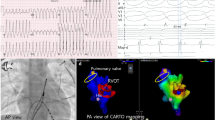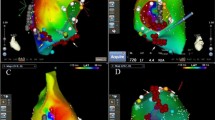Abstract
The need to perform catheter ablation of ventricular arrhythmia from within the sinuses of Valsalva in a pediatric patient is uncommon. This has been reported in adults, but there are little data about the feasibility, safety or efficacy of catheter ablation in the sinuses of Valsalva in the pediatric patients. This is a retrospective review of all patients aged 18 years or less, at two separate institutions with no structural heart disease that underwent an ablation procedure for ventricular arrhythmia mapped to the sinus of Valsalva from 2010 to 2015. We identified 8 total patients meeting inclusion criteria. Median age was 16 years and the median weight was 61 kg. All patients were symptomatic or had developed arrhythmia-induced ventricular dysfunction. Ablation was performed in the left sinus in 4 patients and the right sinus in 4 patients. No ablations were required in the non-coronary sinus. All 8 patients had an acutely successful ablation using radiofrequency energy. There were no complications. At a mean follow-up of 7 months (4–15 months), all patients were known to be living. Follow-up data regarding arrhythmia were available in 6 of the 8 patients, and none had recurrence of their ventricular arrhythmia off of all antiarrhythmic medications. Radiofrequency catheter ablation of ventricular arrhythmia in the sinus of Valsalva can be done safely and effectively in pediatric patients.


Similar content being viewed by others
References
Wilber DJ, Baerman J, Olshansky B, Kall J, Kopp D (1993) Adenosine sensitive ventricular tachycardia: clinical characteristics and response to catheter ablation. Circulation 87:126–134
Lerman BB, Stein K, Markovitz SM (1996) Idiopathic right ventricular outflow tract tachycardia: a clinical approach. Pacing Clin Electrophysiol 19:2120–2137
O’Connor BK, Case CL, Sokoloski MC, Blair H, Cooper K, Gillette PC (1996) Radiofrequency catheter ablation of right ventricular outflow tachycardia in children and adolescents. J Am Coll Cardiol 27:869–874
Kanagaratnam L, Tomassoni G, Schweikert R, Pavia S, Bash D, Beheiry S, Niebauer M, Saliba W, Chung M, Tchou P, Natale A (2001) Ventricular tachycardias arising from the aortic sinus of Valsalva: an under-recognized variant of left outflow tract ventricular tachycardia. J Am Coll Cardiol 37:1408–1414
Gonzalez y Gonzalez MB, Will JC, Tuzcu V, Schranz D, Blaufox AD, Saul JP, Paul T (2003) Idiopathic monomorphic ventricular tachycardia originating from the left aortic sinus cusp in children: endocardial mapping and radiofrequency catheter ablation. Z Kardiol 92:155–163
Morwood JG, Triedman JK, Berul CI, Khairy P, Alexander ME, Cecchin F, Walsh EP (2004) Radiofrequency catheter ablation of ventricular tachycardia in children and young adults with congenital heart disease. Heart Rhythm 3:301–308
Ozyilmaz I, Ergul Y, Akdeniz C, Ozturk E, Tanidir IC, Tuzcu V (2014) Catheter ablation of idopathic ventricular tachycardia in children using the EnSite NavX system with/without fluoroscopy. Cardiol Young 24(5):886–892
Crosson JE, Callans DJ, Bradley DJ, Dubin A, Epstein M, Etheridge S, Papez A, Phillips JR, Rhodes LA, Saul P, Stephenson E, Stevenson W, Zimmerman F (2014) PACE/HRS expert consensus statement on the evaluation and management of ventricular arrhythmias in the child with a structurally normal heart. Heart Rhythm 11:e55–e78
Asirvatham SJ (2009) Correlative anatomy for the invasive electrophysiologist: outflow tract and supravalvar arrhythmia. J Cardiovasc Electrophysiol 20:955–968
Gami AS, Noheria A, Lachman N, Edwards WD, Friedman PA, Talreja D, Hammill SC, Munger TM, Packer DL, Asirvatham SJ (2011) Anatomical correlates relevant to ablation above the semilunar valves for the cardiac electrophysiologist: a study of 603 hearts. J Interv Card Electrophysiol 30:5–15
Hachiya H, Aonuma K, Yamauchi Y, Igawa M, Nogami A, Iesaka Y (2002) How to diagnose, locate, and ablate coronary cusp ventricular tachycardia. J Cardiovasc Electrophysiol 13:551–556
Hoffmayer KS, Dewland TA, Hsia HH, Badhwar N, Hsu JC, Tseng ZH, Marcus GM, Scheinman MM, Gerstenfeld EP (2014) Safety of radiofrequency catheter ablation without coronary angiography in aortic cusp ventricular arrhythmias. Heart Rhythm 11:1117–1121
Schneider HE, Kriebel T, Jung K, Grevenhorst VD, Paul T (2010) Catheter ablation of idiopathic left and right ventricular tachycardias in the pediatric population using noncontact mapping. Heart Rhythm 7:731–739
Pons M, Beck L, Leclercq F, Ferriere M, Albat B, Davy J (1997) Chronic left main coronary artery occlusion: a complication of radiofrequency ablation of idopathic left ventricular tachycardia. PACE 20:1874–1876
Author’s Contribution
Philip L. Wackel, MD was involved in concept/design, data collection and drafting/editing/revision of the article. Andrew W. McCrary, MD and Salim F. Idriss, MD PhD were involved in data collection and editing/revision of article. Samuel J. Asirvatham, MD was involved in editing/revision of article. Bryan C. Cannon, MD was involved in concept/design and editing/revision of the article.
Funding
There was no funding for this study.
Author information
Authors and Affiliations
Corresponding author
Ethics declarations
Conflict of interest
Bryan Cannon is a paid consultant for Medtronic. The remaining authors declare that they have no conflict of interest.
Rights and permissions
About this article
Cite this article
Wackel, P.L., McCrary, A.W., Idriss, S.F. et al. Radiofrequency Ablation in the Sinus of Valsalva for Ventricular Arrhythmia in Pediatric Patients. Pediatr Cardiol 37, 1534–1538 (2016). https://doi.org/10.1007/s00246-016-1467-7
Received:
Accepted:
Published:
Issue Date:
DOI: https://doi.org/10.1007/s00246-016-1467-7




